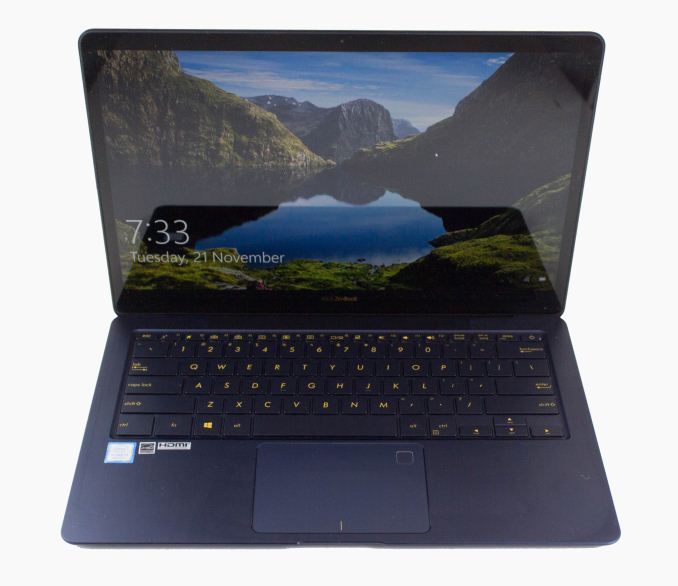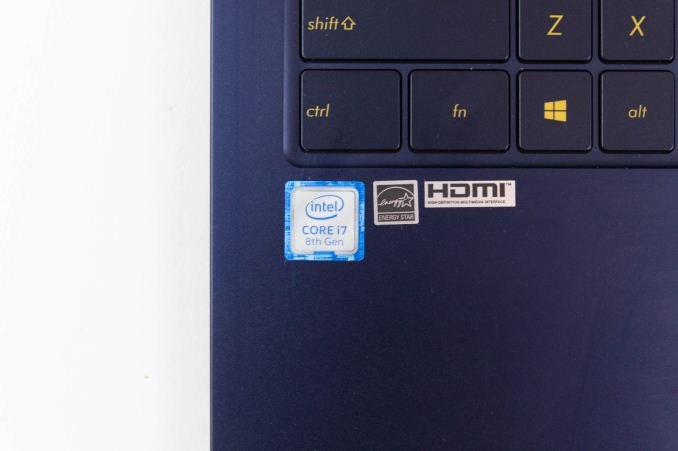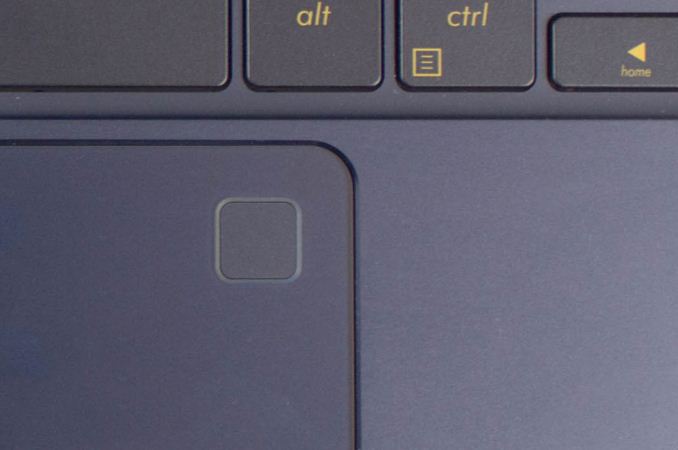The ASUS ZenBook 3 Review: A Convincing Case for Quad Core Thin & Light Laptops
by Brett Howse on November 22, 2017 8:00 AM EST- Posted in
- Laptops
- Asus
- Zenbook
- Core 8th Gen
- Kaby Lake Refresh

ASUS is a company that doesn’t shy away from the latest technology, and with the new ZenBook 3 UX490UA, they’ve updated one of their thinnest and lightest machines to include the latest Intel 8th Generation processors. It’s likely no surprise to any of our readers what this means, but for those who are just now dipping their toes into Intel's newest processors, this is Kaby Lake Refresh, which features the first ever quad-core ultramobile Core processor from Intel. ASUS in turn has packed Intel's latest processor into a small, lightweight chassis, with all of the features expected in a modern Ultrabook.
With the ASUS ZenBook 3, the company currently offers two models. The original ZenBook 3, which ASUS continues to offer, features a Core i7-7500U CPU, a dual-core hyperthreading-enabled CPU with a base of 2.7 GHz and boost of 3.5 GHz. Joining the family with the launch of Kaby Lake Refresh is a new model based around a Core i7-8550U CPU, which is the new quad-core with hyperthreading, running at a base frequency of 1.8 GHz and boosting up to 4.0 GHz. Relative to the 7500U model, the 8550U model's base frequency is a bit lower to accommodate the extra cores, but for workloads without as many threads, the 4.0 GHz top boost speed is a big jump over the 3.5 GHz top speed of the previous generation chip.
Today we're taking a look at the newer 8550U-based model. Given that it's a minor refresh of the existing ZenBook 3 design, a lot of the focus is going to be on the new CPU, and for good reason. While Intel's 8th generation Core lineup is unfortunately a bit of a mess (more on that in a bit), but it's a significant update at almost every level of Intel's product stack, thin & light ultrabooks included. Whereas all Intel 15 Watt CPUs before now have been dual-core designs, Kaby Lake Refresh bumps that up to a quad-core, which as we'll see makes for some rather potent performance boosts in even moderately threaded scenarios. This in turn is a rather significant development for Ultrabooks: the thin & light laptops have always been about tradeoffs – giving up performance and some ports for portability – however the release of a quad-core CPU suitable for these laptops means that Ultrabooks can now reach into performance tiers previously restricted to larger laptops.
Not that the ZenBook 3 is all about its CPU, of course. As mentioned previously, ASUS has not shied away from packing in all the latest tech either. The ZenBook 3 UX490UA features a 14-inch 1920x1080 IPS panel, with thin display bezels, allowing the laptop to be much more compact that older 14-inch models would be. They’ve outfitted the laptop with 16 GB of LPDDR3 memory, and 256 GB of SATA SSD, or 512 GB of PCIe 3.0 x 4 NVMe storage.
| ASUS ZenBook 3 UX490UA | |||||
| Model Tested: Core i7-8550U, 512GB SSD, $1699 | |||||
| Processor | Intel Core i7-7500U (2C/4T, 2.7-3.5 GHz 15W) Intel Core i7-8550U (4C/8T, 1.8-4.0GHz, 15W) |
||||
| Memory | 16 GB Dual-Channel LPDDR3-2133 | ||||
| Graphics | 7500U: Intel HD 620 (24 EUs, 300MHz-1.05GHz) 8550U: Intel UHD 620 (24 EUs, 300MHz-1.15GHz) |
||||
| Display | 14" 1920x1080 16:9 IPS Corning Gorilla Glass 5 Non-Touch 100% sRGB color |
||||
| Storage | 256GB SATA / 512GB NVMe | ||||
| Networking | 802.11ac, 2x2:2, 866Mbps Max, 2.4 and 5GHz Bluetooth 4.1 Intel Dual Band Wireless-AC 8265 |
||||
| Audio | Quad-speakers Harman Kardon Certified |
||||
| Battery | 46 Wh, 65 W AC Adapter USB-C Charging | ||||
| Right Side | USB-C w/Thunderbolt 3 USB-C 3.1 Gen 1 (5Gbps) with Display and Power Delivery |
||||
| Left Side | 3.5mm Headset Jack USB-C w/Thunderbolt 3 |
||||
| Dimensions | 329 x 210 x 12.9 mm (12.95 x 8.279 x 0.51 inches) | ||||
| Weight | 1.1 kg / 2.42 lbs | ||||
| Cameras | VGA Web Cam | ||||
| Pricing | Core i7-7500U $1579 USD Core i7-8550U $1699 USD |
||||
Some laptops are still debating whether to offer USB-C, but ASUS has gone all-in with two Thunderbolt 3-equipped USB-C ports and a further standard USB 3.1 Gen 1 (5 Gbps) port. All three USB-C ports offer upstream charging, while the Thunderbolt ports add TB3 data speeds, dual 4K display output, and USB 3.1 Gen 2 (10 Gbps) data transfer capabilities to the mix. Wireless connectivity is provided by an Intel Dual Band Wireless-AC 8265 adapter. This is one of the most reliable ones available, and offers excellent 2x2:2 performance, but also MU-MIMO and Bluetooth 4.1.
ASUS has even found room for a fingerprint reader, which allows Windows Hello login.
Although ASUS lists a 256 GB model, it doesn't appear to be for sale anywhere at the moment.
ASUS packs all of this into a laptop that’s only 1.1 kg / 2.42 lbs, and 12.9 mm / 0.51 inches thick. It’s available in both a striking Royal Blue, or a Quartz Gray finish on the “aerospace-grade aluminum alloy” which ASUS says is 50% stronger than the standard aluminum alloy.
Let’s dig into the design and see how they did.












55 Comments
View All Comments
tipoo - Wednesday, November 22, 2017 - link
Any idea when these ULV quads will be combined with Iris Plus, which is presumably what Apple would be waiting on?KPOM - Wednesday, November 22, 2017 - link
Unfortunately there may not be sufficient space in the 15W wrapper to permit better integrated graphics. New MacBook Pros aren’t likely to come out until next spring, anyway.poohbear - Wednesday, November 22, 2017 - link
I'm still loving my 4xxx gen Zenbook, aside from having to replace the keyboard, it's been kicking around for nearly 4 years now with no probs. Solid line of laptops and very sleek. Will definitely look @ the 9xxx Zenbook for my next upgrade! Really want to see what 10nm brings to the table!cyborgu - Wednesday, November 22, 2017 - link
Do the Thunderbolt 3 ports provide 2 PCIe lanes or 4? I was very disappointed to find out that my XPS 13 only has 2 lanes available for an external GPU.serendip - Wednesday, November 22, 2017 - link
17 fps on a Cherry Trail Atom which is exactly what I got too, on a Teclast X98. I was wondering why QuickSync was so slow on an Atom when it's just the Atom that's slow.I'm surprised about the Zenbook's overall efficiency though. It's comparable to a Core M device while having double the performance. I wonder how much of this is down to the CPU, given the screen is a large hi-res unit and the battery is rather small.
speculatrix - Saturday, November 25, 2017 - link
Can you boot Linux at all, and if so, are all devices recognized?Thanks
MatthiasP - Sunday, November 26, 2017 - link
Asus made an almost perfect thin and light laptop and then put a dark and glossy display in. WOW.Qiou87 - Monday, November 27, 2017 - link
I've had the chance to work with a UX390 and now on a XPS13 (with 8th gen i5). Both are impressive machines. I do appreciate the long battery life of the XPS13, I get well over a day of work out of the battery, closer to two, and the more versatile connectivity (USB-A is still king today and for the next couple years at least). It's also nice to be able to forget your power supply and not care.One thing that would put me off this UX490 but is not mentioned in this review: this seems to be a non-mate display. Quite baffling since this is no touch screen. Try using one of those on the train, or a plane sitting next to the window, especially with the low maximum brightness. Mate displays are just more usable, I feel, if you don't use touch. With a mate display you can lower the screen brightness and get that much more battery life...
Manch - Tuesday, December 5, 2017 - link
I didnt like the glosdy screen on my ASUS ux501 so Iut a matte screen protector on it. Works greatManch - Tuesday, December 5, 2017 - link
I put